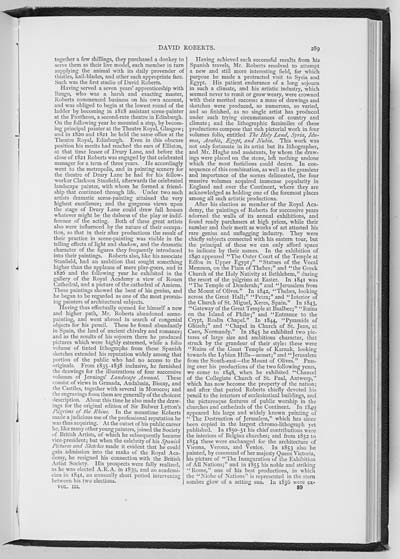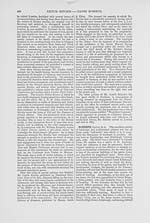289
together a few shillings, they purchased a donkey to
serve them as their live model, each member in turn
supplying the animal with its daily provender of
thistles, kail-blades, and other such appropriate fare.
Such was the first studio of David Roberts.
Having served a seven years' apprenticeship with
Beugo, who was a harsh and exacting master,
Roberts commenced business on his own account,
and was obliged to begin at the lowest round of the
ladder by becoming in 1818 assistant scene-painter
at the Pantheon, a second-rate theatre in Edinburgh.
On the following year he mounted a step, by becom-
ing principal painter at the Theatre Royal, Glasgow;
and in 1820 and 1821 he held the same office at the
Theatre Royal, Edinburgh. Even in this obscure
position his merits had reached the ears of Elliston,
at that time lessee of Drury Lane, and before the
close of 1821 Roberts was engaged by that celebrated
manager for a term of three years. He accordingly
went to the metropolis, and in painting scenery for
the theatre of Drury Lane he had for his fellow-
worker Clarkson Stanfield, afterwards the celebrated
landscape painter, with whom he formed a friend-
ship that continued through life. Under two such
artists dramatic scene-painting attained the very
highest excellence; and the gorgeous views upon
the stage of Drury Lane could draw full houses
whatever might be the dulness of the play or indif-
ference of the acting. Both of these great artists
also were influenced by the nature of their occupa-
tion, so that in their after productions the result of
their practice in scene-painting was visible in the
telling effects of light and shadow, and the dramatic
character of the figures they frequently introduced
into their paintings. Roberts also, like his associate
Stanfield, had an ambition that sought something
higher than the applause of mere play-goers, and in
1826 and the following year he exhibited in the
gallery of the Royal Academy a view of Rouen
Cathedral, and a picture of the cathedral of Amiens.
These paintings showed the bent of his genius, and
he began to be regarded as one of the most promis-
ing painters of architectural subjects.
Having thus effectually opened for himself a new
and higher path, Mr. Roberts abandoned scene-
painting, and went abroad in search of congenial
objects for his pencil. These he found abundantly
in Spain, the land of ancient chivalry and romance;
and as the results of his sojourn there he produced
pictures which were highly esteemed, while a folio
volume of tinted lithographs from these Spanish
sketches extended his reputation widely among that
portion of the public who had no access to the
originals. From 1835-1838 inclusive, he furnished
the drawings for the illustrations of four successive
volumes of Jennings' Landscape Annual. These
consist of views in Granada, Andalusia, Biscay, and
the Castiles, together with several in Morocco; and
the engravings from them are generally of the choicest
description. About this time he also made the draw-
ings for the original edition of Sir Bulwer Lytton's
Pilgrims of the Rhine. In the meantime Roberts
made a judicious use of the professional reputation he
was thus acquiring. At the outset of his public career
he, like many other young painters, joined the Society
of British Artists, of which he subsequently became
vice-president; but when the celebrity of his Spanish
Pictures and Sketches made it evident that he could
gain admission into the ranks of the Royal Aca-
demy, he resigned his connection with the British
Artist Society. His prospects were fully realized,
as he was elected A.R.A. in 1839, and an academi-
cian in 1841, an unusually short period intervening
between his two elections.
VOL. III.
Having achieved such successful results from his
Spanish travels, Mr. Roberts resolved to attempt
a new and still more interesting field, for which
purpose he made a protracted visit to Syria and
Egypt. His patient endurance of a long sojourn
in such a climate, and his artistic industry, which
seemed never to remit or grow weary, were crowned
with their merited success: a mass of drawings and
sketches were produced, so numerous, so varied,
and so finished, as no single artist has produced
under such trying circumstances of country and
climate; and the lithographic facsimiles of these
productions compose that rich pictorial work in four
volumes folio, entitled The Holy Land, Syria, Idu-
mea, Arabia, Egypt, and Nubia. This work was
not only fortunate in its artist but its lithographer,
and Mr. Haghe and assistants, by whom the draw-
ings were placed on the stone, left nothing undone
which the most fastidious could desire. In con-
sequence of this combination, as well as the grandeur
and importance of the scenes delineated, the four
massive volumes acquired immense popularity in
England and over the Continent, where they are
acknowledged as holding one of the foremost places
among all such artistic productions.
After his election as member of the Royal Aca-
demy, the paintings of Roberts for successive years
adorned the walls of its annual exhibitions, and
found ready purchasers at high prices, while their
number and their merit as works of art attested his
rare genius and unflagging industry. They were
chiefly subjects connected with his eastern tour, but
the principal of these we can only afford space
to indicate by their names. In the exhibition of
1840 appeared "The Outer Court of the Temple at
Edfou in Upper Egypt;" "Statues of the Vocal
Memnon, on the Plain of Thebes;" and "the Greek
Church of the Holy Nativity at Bethlehem," during
the resort of the pilgrims at Easter. In 1841 was
"The Temple of Denderah;" and "Jerusalem from
the Mount of Olives." In 1842, "Thebes, looking
across the Great Hall;" "Petra;" and "Interior of
the Church of St. Miguel, Xeres, Spain." In 1843,
'' Gateway of the Great Temple at Baalbec;" '' Ruins
on the Island of Phil�;" and "Entrance to the
Crypt, Roslin Chapel." In 1844, "Pyramids of
Ghizeh;" and "Chapel in Church of St. Jean, at
Caen, Normandy." In 1845 he exhibited two pic-
tures of large size and ambitious character, that
struck by the grandeur of their style: these were
"Ruins of the Great Temple of Karnak, looking
towards the Lybian Hills�sunset;" and "Jerusalem
from the South-east�the Mount of Olives." Pass-
ing over his productions of the two following years,
we come to 1848, when he exhibited "Chancel
of the Collegiate Church of St. Paul, Antwerp,"
which has now become the property of the nation;
and after that period Roberts chiefly devoted his
pencil to the interiors of ecclesiastical buildings, and
the picturesque features of public worship in the
churches and cathedrals of the Continent. In 1849
appeared his large and widely known painting of
" The Destruction of Jerusalem," which has since
been copied in the largest chromo-lithograph yet
published. In 1850-51 his chief contributions were
the interiors of Belgian churches; and from 1852 to
1854 these were exchanged for the architecture of
Vienna, Verona, and Venice. In 1853 also he
painted, by command of her majesty Queen Victoria,
his picture of "The Inauguration of the Exhibition
of All Nations;" and in 1855 his noble and striking
"Rome," one of his best productions, in which
the "Niobe of Nations" is represented in the stern
sombre glow of a setting sun. In 1856 were ex-
89

![]() Universal Viewer |
Universal Viewer | ![]() Mirador |
Large image | Transcription
Mirador |
Large image | Transcription
![]()

